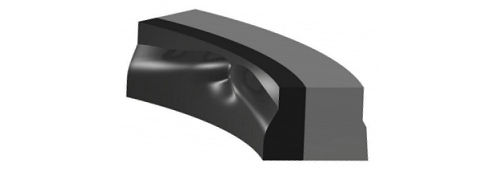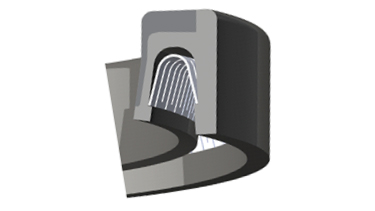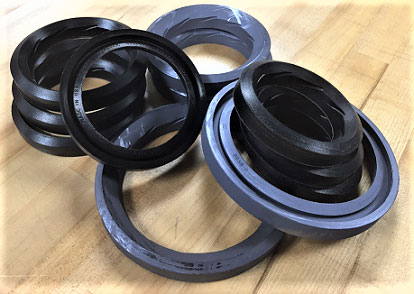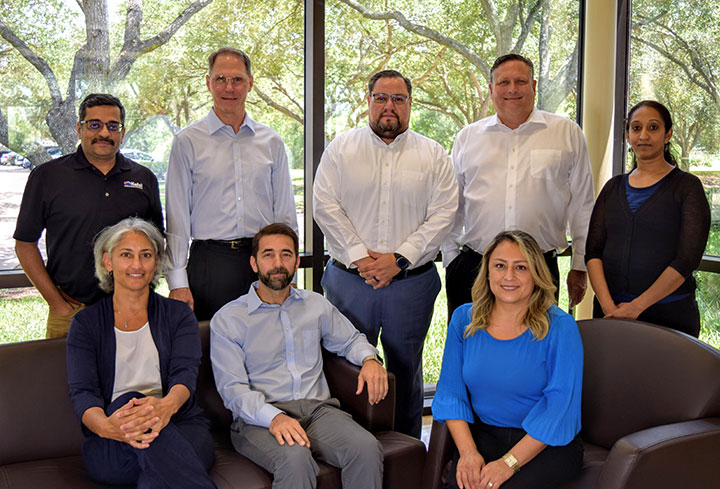Is there an ideal rotary shaft seal?
Overview of rotary shaft seals
Rotary shaft seals exist in a wide variety of designs. In the universe of rotary sealing applications, operating conditions vary significantly, and engineered solutions have been developed that are _tailored to specific conditions and application constraints. No single seal design is ideal for all operating conditions. For example, the garter spring energized radial shaft seals that work extremely well in automotive axles would be a disaster as a high pressure seal in a hydraulic swivel, or an oilfield rotating control device (RCD), or a sealed bearing mud motor. The same is true of the face seals that run flawlessly in automotive and swimming pool water pumps for thousands of hours. Each application has its own challenges, and the very features that provide high performance in some applications may lead to rapid failure in others. The best rotary shaft seal design is the one that meets the specific needs of the application.
Introduction to Kalsi-brand rotary shaft seals
Kalsi Seals® are polymeric rotary shaft seals that are installed with radial squeeze. They are designed for lubricant retention applications that involve moderate to extreme differential pressure and may also have an abrasive operating environment. Within this general category, specialized seal designs have been developed for specific conditions. Most Kalsi Seals are designed to have the differential pressure act from the lubricant side, but several designs have been developed that allow the environment side fluid to be at a higher pressure. Information on specific shaft seal types is summarized below.
All Kalsi-brand shaft seals have features on the dynamic surface, referred to as waves, that pump a microscopic film of lubricant into the dynamic interface between the seal and the shaft during periods of shaft rotation. This lubricating film minimizes adhesive wear, reduces seal generated heat and associated loss of material strength, and allows a wide dynamic lip to be used. The robust dynamic lip width provides strength that helps the seals withstand differential pressure, and also provides sacrificial material to accommodate axially acting seal wear that can occur due to factors such as third body wear and high-pressure extrusion damage.
In terms of sealing differential pressure, Kalsi-brand shaft seals can be divided into three categories: Seals for low and potentially reversing levels of differential pressure, seals for low to extreme differential pressure acting from the lubricant side, and seals for relatively high differential pressure acting from the environment side.
Key shaft seal design variables
Kalsi Seals are available in a range of styles, to address various operating conditions and application constraints. The following paragraphs describe the key design variables.
Lip width — One seal design variable is the width of the dynamic sealing lip. As a general rule, narrower lips tend to run cooler in lower differential pressure applications, while wider lips resist high pressure extrusion better, and offer more sacrificial material for axially acting wear mechanisms such as extrusion damage and third body wear.
Wave type — Another seal design variable is the degree of lubrication the waves provide. More aggressive waves increase lubrication, promote cooler operation, and support higher differential pressure, wider dynamic lips, and higher modulus, more extrusion resistant lip materials. They also allow the use of lower viscosity seal lubricants, but have a higher hydrodynamic pumping related leak rate.
Edge configuration — Some of our shaft seal designs incorporate a feature that causes elevated contact pressure near the environment edge of the dynamic sealing interface, for improved exclusion of abrasive environmental fluid in low or reversing pressure conditions.
Body design — Most Kalsi Seals are direct compression elements that are installed with radial squeeze, and seal statically in the same manner as O-rings. One type of Kalsi Seal is a spring-loaded lip seal design that withstands much higher pressures than conventional radial shaft seals. They were developed for use in severe duty applications such as oilfield rotary control devices. One seal design also utilizes axial seal body constraint, to improve third body wear resistance in applications with abrasive environmental fluid and low levels of reversing pressure.
Seal material — Many of our shaft seals are available in several different materials that are directed at specific operating conditions. HNBR is widely used for its good resistance to abrasion and extrusion damage. In one product line these characteristics are augmented with fabric reinforcement. FKM is used in applications with higher temperature, breakout torque constraints, or unique chemical resistance requirements. (A special treatment is available to reduce the breakout torque of HNBR seals.) Dual Durometer™ HNBR construction allows the use of a high modulus seal material at the shaft to housing extrusion gap clearance, without the associated increase in interfacial contact pressure that would result from the high modulus material being used throughout the seal body. Plastic liners, when used with aggressive hydrodynamic inlets, provide better extrusion resistance than the best dual durometer construction, and also provide low breakout torque.
Overview of Kalsi-brand rotary shaft seals constructed entirely from elastomer

Standard Kalsi Seals™ are all-elastomer, direct compression rotary shaft seals that have the original “standard” lip width and low hydrodynamic pumping-related lubricant consumption. They are intended for use in applications where a wider lip may be less desirable from the standpoint of breakout torque, and where moderate differential pressure acts from the lubricant side of the seal. When used in applications with zero differential pressure and abrasive environment media, the use of axial spring loading is recommended.
Wide Footprint Seals™ are designed for partitioning a lubricant from an environment in conditions where the pressure of the lubricant is higher than the pressure of the environment, and lubricant consumption by the seal must be minimal. The dynamic lip is significantly wider than that of the Standard Kalsi Seal™. This increases resistance to differential pressure, and provides additional sacrificial material to address various wear mechanisms. Wide Footprint Seals also have increased radial compression, which provides improved resistance to shaft deflection and helps them to tolerate more wear. These features help Wide Footprint Seals provide longer life in applications such as the fixed location seal of an oilfield sealed bearing mud motor or rotary steerable drilling tool.
Axially Constrained Seals™ are designed for partitioning a lubricant from an abrasive environment in conditions where the differential pressure is essentially zero, but may rise slightly in either axial direction. An example of a typical application is the pressure compensation piston of an oilfield sealed bearing mud motor. The features that allow such service are a specially designed seal body that contacts both groove walls, and an environment side chamfer that increases interfacial contact pressure on the environment side of the seal. Several other types of Kalsi-brand rotary shaft seals can also be used for this type of service if axially spring loaded.
Hybrid Seals™ and Enhanced Lubrication Seals™ are designed for lubricant pressure retention and environmental exclusion in applications that can tolerate higher hydrodynamic pumping related leakage, or require the use of low viscosity lubricants. They are available with several different types and ratios of waves that can be tailored to provide a wide range of lubricating efficiency. They are available in several different lip widths, from the “standard” width all the way up to extremely wide. When used with dual durometer construction these rotary shaft seals provide the highest pressure capacity of our all-elastomer shaft seal product line. These rotary seals are especially appropriate for use in demanding high pressure applications such as hydraulic swivels and lubricant overpressure-type rotating control devices. The pressure capacity can be further increased with the use of floating backup rings or floating seal carriers. For information on a 40 day, 5,000 psi test with 0.010” of intentional runout, click here.
High Film Seals™ are for rotary shaft seal applications with unidirectional rotation. They have very aggressive clockwise or counter-clockwise waves that produce a high hydrodynamic pumping related lubricant leak rate. Our cement pump cartridge uses this pumping rate to pressurize and flush a stack of lip seals that are being used to exclude low pressure cement. The flushing action of the High Film Seal™ lubricates the lip and seals and helps to flush away interfacial contaminants. The cement pump cartridge also utilizes special purpose Filled Kalsi Seals™ as outboard lubricant retention seals that generate less heat than solid cross-section Kalsi Seals. High Film Seals can also be used as pressure-retaining RCD seals, if used with an outboard leakage collection seal.
Grooved Kalsi Seals™ are an older type of RCD seal that has been largely supplanted by more advanced Kalsi Seal designs.
Overview of Kalsi-brand rotary shaft seals constructed partially from plastic
Plastic Lined Kalsi Seals™ are direct compression-type high pressure rotary shaft seals. They have an elastomer body, a high-performance plastic lining, and aggressive hydrodynamic waves. The plastic lining has a much higher modulus than any elastomer-type seal material, which makes Plastic Lined Kalsi Seals our most pressure-capable rotary shaft seals. The pressure capacity can be further enhanced by using the seals in conjunction with our patented floating backup rings. Click here to read about a 1,000 hour, 7,500 psi (51.71 MPa) test, and click here to read about a 368 hour, 10,000 psi (68.95 MPa) test.

BDRP Seals™ are a variation of the Plastic Lined Kalsi Seal design that has been adapted to handle lubricant pressure in either axial direction. These high pressure shaft seals have the same extreme pressure capacity as Plastic lined Kalsi Seals in one axial direction, and have been tested up to 1,500 psi in the opposite pressure direction. BDRP seals were developed for applications with bidirectional pressure, such as high pressure hydraulic swivels. Consider using these unique hydraulic shaft seals instead of traditional cap seals when higher speeds are needed.
KLS® Seals are high pressure lip seals with hydrodynamic inlets that provide interfacial lubrication in relatively high differential pressure operating conditions. KLS seals come in clockwise and counter-clockwise versions. They were designed to serve as RCD seals in lower cost RCDs that do not employ lubricant overpressure. Duration testing directed at the RCD market has been conducted with 1,000 psi (6.89 MPa) at 543 sfpm (2.76 m/s) and 1,500 psi (10.34 MPa) at 137 sfpm (0.7 m/s). Click here for information on implementing this unique lip seal design in RCDs.

High Pressure washpipe packing
Kalsi Washpipe packing is a high-performance replacement for the washpipe packing used in oilfield top drives and power swivels. It is typically implemented in a rotating seal housing. Interchangeable with conventional packing and made with the same fabric-reinforced elastomer seal material, it incorporates hydrodynamic waves that help the packing to run cooler, with less wear. Use these innovative rotating shaft seals when higher speeds and pressures are anticipated.

Kalsi family of rotary shaft seals — Standard & custom seal solutions
The Kalsi family of rotary shaft seals is uniquely suited to excel under demanding operational and environmental conditions. Whether your need is a for a low pressure or a high pressure shaft seal, one of our patented rotary sealing solutions may provide the high performance, reliability and economic advantage your equipment needs. For information on the design and performance characteristics of Kalsi Seals, see the technical section of our rotary seal handbook. For available seal sizes, see our online rotary shaft seal catalog. For assistance in selecting and implementing Kalsi-brand rotary seals, or obtaining a custom shaft seal design, please forward a completed application questionnaire or contact us by e-mail or telephone.
